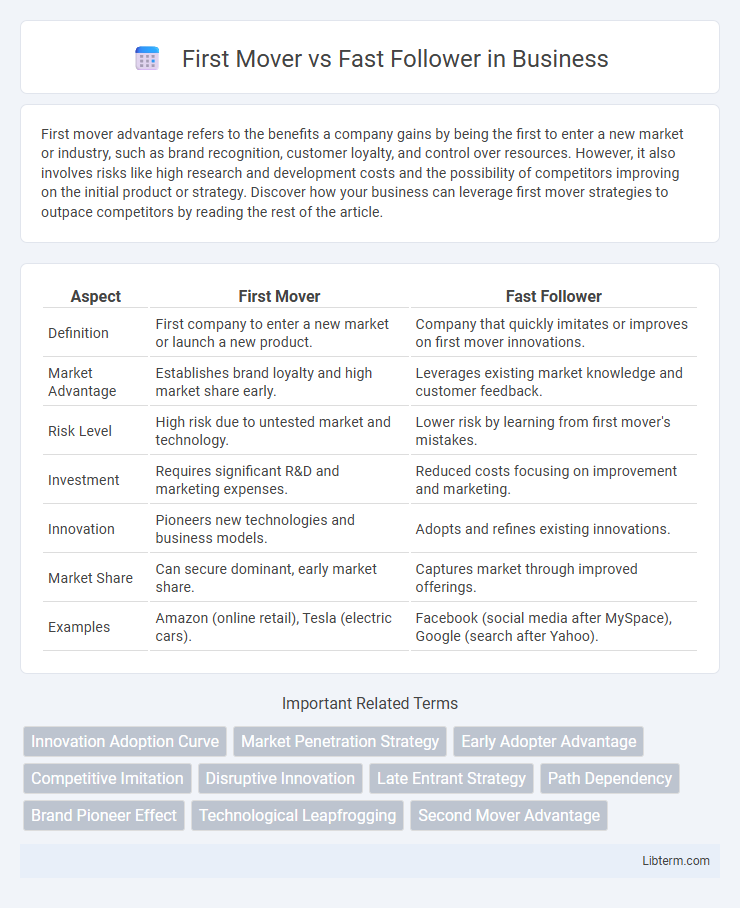First mover advantage refers to the benefits a company gains by being the first to enter a new market or industry, such as brand recognition, customer loyalty, and control over resources. However, it also involves risks like high research and development costs and the possibility of competitors improving on the initial product or strategy. Discover how your business can leverage first mover strategies to outpace competitors by reading the rest of the article.
Table of Comparison
| Aspect | First Mover | Fast Follower |
|---|---|---|
| Definition | First company to enter a new market or launch a new product. | Company that quickly imitates or improves on first mover innovations. |
| Market Advantage | Establishes brand loyalty and high market share early. | Leverages existing market knowledge and customer feedback. |
| Risk Level | High risk due to untested market and technology. | Lower risk by learning from first mover's mistakes. |
| Investment | Requires significant R&D and marketing expenses. | Reduced costs focusing on improvement and marketing. |
| Innovation | Pioneers new technologies and business models. | Adopts and refines existing innovations. |
| Market Share | Can secure dominant, early market share. | Captures market through improved offerings. |
| Examples | Amazon (online retail), Tesla (electric cars). | Facebook (social media after MySpace), Google (search after Yahoo). |
Defining First Mover and Fast Follower Strategies
First mover strategy involves entering a market early to establish brand recognition, set industry standards, and secure customer loyalty before competitors. Fast follower strategy focuses on quickly analyzing the first mover's successes and failures, then entering the market with improved products or lower costs to capture market share. Companies like Amazon exemplify fast followers by refining existing innovations, while firms like Apple often act as first movers by launching groundbreaking technologies.
Historical Overview of First Movers in Business
First movers in business historically gained competitive advantages by entering markets early, often securing brand recognition, customer loyalty, and control over critical resources. Notable examples include companies like Amazon in e-commerce and Coca-Cola in soft drinks, which capitalized on pioneering innovations to establish dominant market positions. However, first movers also faced high risks and costs associated with market development and technology adoption, which sometimes led to vulnerabilities exploited by fast followers.
The Fast Follower Approach: An Emerging Trend
The fast follower approach is gaining traction as businesses seek to leverage the pioneering efforts of first movers while minimizing risks and costs. By quickly adopting and improving upon innovations, fast followers capitalize on validated market demand, accelerated product development, and refined customer targeting strategies. This emerging trend emphasizes agility and strategic adaptation, enabling companies to achieve competitive advantage without the burdens of initial market uncertainty.
Key Advantages of Being a First Mover
First movers secure significant competitive advantages by establishing strong brand recognition and customer loyalty before competitors enter the market. Early market entry enables them to set industry standards, control scarce resources, and create high switching costs for customers. These advantages often translate into increased market share, higher profit margins, and long-term dominance within the industry.
Risks and Drawbacks of First Mover Strategy
First mover strategy carries significant risks, including high research and development costs and the potential for market uncertainty due to untested demand. Early entrants may face difficulties in educating consumers and establishing standards, while fast followers can capitalize on first movers' mistakes and improve upon their innovations. Additionally, first movers risk rapid technological obsolescence and substantial investment losses if competitors quickly introduce superior alternatives.
Benefits of Fast Follower Tactics
Fast follower tactics benefit from reduced market risks by learning from the first mover's mistakes and customer feedback, enabling more informed product development. They capitalize on established market demand and can optimize pricing and marketing strategies based on the pioneer's experiences. This approach often results in faster innovation cycles and higher adaptability to changing consumer preferences, increasing the likelihood of long-term competitive advantage.
Case Studies: First Movers Who Succeeded or Failed
First movers like Amazon revolutionized e-commerce by capitalizing on early market entry and technology innovation, securing dominant market share and brand loyalty. However, other pioneers such as Friendster faltered due to inadequate scalability and user retention, allowing fast followers like Facebook to capture and expand the social networking market. These contrasting case studies demonstrate that first-mover advantage depends heavily on execution, continuous innovation, and the ability to adapt to shifting consumer preferences.
Fast Follower Success Stories in Modern Markets
Fast followers excel in modern markets by rapidly adopting and improving innovations introduced by first movers, minimizing risks associated with untested markets. Companies like Facebook capitalized on MySpace's initial social networking concept by offering a more user-friendly interface and enhanced features, leading to massive user growth and market dominance. Similarly, Google succeeded by refining early search engine technologies, demonstrating that strategic timing and execution can outpace pioneering efforts.
Industry-Specific Considerations: Choosing the Right Strategy
In the technology sector, first movers benefit from establishing brand loyalty and setting industry standards but face high R&D costs and market uncertainty. Fast followers thrive in consumer goods by leveraging proven concepts to improve products and reduce market risks while quickly capturing market share. Industries with rapid innovation cycles, like pharmaceuticals, may favor first movers for patent advantages, whereas fast followers excel in retail by adapting swiftly to consumer trends.
Strategic Recommendations: When to Move First or Follow Fast
First movers gain competitive advantage by establishing brand loyalty and securing key resources early, ideal in markets with high entry barriers and opportunities for innovation monopolies. Fast followers benefit from observing first movers' failures and refining offerings, optimal in rapidly evolving industries where technology and consumer preferences shift quickly. Strategic decisions should weigh market conditions, innovation pace, resource availability, and risk tolerance to determine whether initiating or timing entry after competitors maximizes long-term value.
First Mover Infographic

 libterm.com
libterm.com